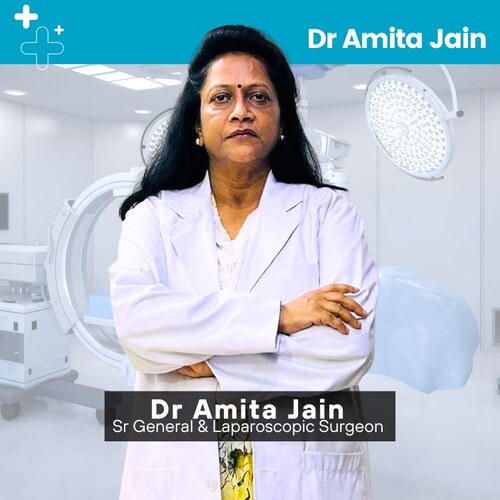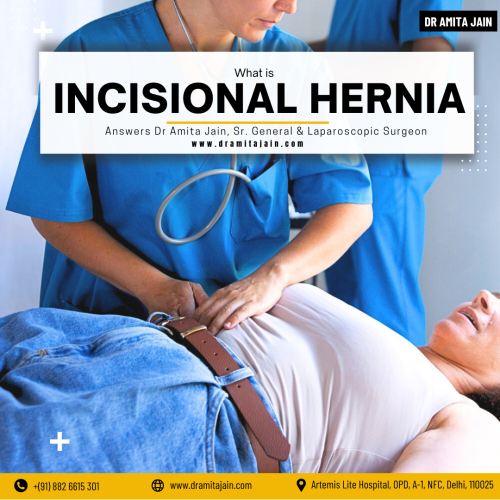Surgical procedures are often necessary to treat various medical conditions, and while most people recover without any issues, some may experience complications during the healing process. One such complication is an incisional hernia, which can develop at the site of a previous surgical incision.
Although common, this condition requires timely medical attention to prevent discomfort and more serious complications. Understanding what an incisional hernia is and how it is treated can help patients make informed decisions about their recovery, shares Dr Amita Jain who is an eminent general and laparoscopic surgeon, and one of the best specialised surgeon for incisional hernia.
What is an Incisional Hernia?
An incisional hernia occurs when tissue, such as part of the intestine or abdominal fat, pushes through a weak spot or an incompletely healed area in the abdominal wall where a surgical incision was made. This condition is a type of ventral hernia, which refers to any hernia occurring in the abdominal wall.
Incisional hernias may develop weeks, months, or even years after surgery. They often present as a noticeable bulge near or at the site of the surgical scar. This bulge may become more pronounced when a person is standing, coughing, or straining.
Causes and Risk Factors
An incisional hernia typically results from poor healing or weakness in the abdominal muscles following surgery. The likelihood of developing this type of hernia increases in individuals who are obese, experience poor wound healing, or have had an infection at the surgical site. Additional contributing factors include engaging in heavy lifting soon after surgery, having undergone multiple abdominal surgeries, or suffering from conditions that increase intra-abdominal pressure such as chronic coughing or constipation.
Signs and Symptoms
A common symptom of an incisional hernia is a visible bulge in the abdomen near the previous incision site. People may also experience discomfort or pain around the bulge, particularly when lifting objects or bending over. Some individuals report a sensation of weakness or pressure in the abdominal area. In severe cases, symptoms may include nausea, vomiting, or signs of bowel obstruction, which require immediate medical attention.
Diagnosis
Doctors usually begin the diagnosis with a physical examination, checking for the presence of a bulge that becomes more noticeable when the patient is standing or straining. To further assess the size and contents of the hernia, imaging tests such as an ultrasound, CT scan, or MRI may be performed.
Treatment Options for Incisional Hernia
The only definitive treatment for an incisional hernia is surgical repair. The choice of surgery depends on the size, location, and complexity of the hernia, as well as the patient’s overall health.
1. Open Hernia Repair – A traditional surgical method where the surgeon makes an incision over the hernia, pushes the protruding tissue back into place, and closes the abdominal wall using stitches or a surgical mesh for reinforcement.
2. Laparoscopic (Minimally Invasive) Repair – Small incisions are made, and surgical instruments, along with a camera, are used to repair the hernia with mesh. This method offers faster recovery, less pain, and smaller scars.
3. Robotic Hernia Repair – An advanced technique similar to laparoscopy, but using robotic arms for more precise movements. It’s increasingly preferred for complex or recurrent hernias.
An incisional hernia, while not uncommon, should not be ignored. It can cause discomfort and potentially lead to serious complications if left untreated. With advancements in surgical techniques, incisional hernias can be repaired effectively, allowing patients to return to a normal and active life. If you notice a bulge or discomfort near a past surgical site, consult a healthcare professional promptly for assessment and guidance

Dr Amita Jain is one of India’s most distinguished and experienced female surgeons, known for her unmatched expertise in general and laparoscopic surgery. With over 29 years of surgical excellence, Dr Amita Jain has built a reputation for precision, compassionate care, and advanced surgical techniques.
Dr Amita Jain has successfully performed a wide range of complex general surgeries, including both open and minimally invasive procedures, with a strong focus on trauma care, onco-surgical techniques, and reconstructive surgeries. Her areas of specialisation include (including Gallbladder stone removal, appendix removal, hernia repair surgery, piles and fissure surgeries). She was the Professor of Surgery at the Army College of Medical Sciences and Base Hospital, Delhi Cantt. In 1994, she was commissioned asa Surgeon under the United Nations Mission in Congo. From 2020 to 2022, she worked with Bansals Hospital. Currently, Dr Amita Jain is the Senior General and Laparoscopic Surgeon at Rainbow Children Hospitals (Malviya Nagar, Delhi), Artemis Lite: Multi-Speciality Care Hospital (New Friends Colony, New Delhi) and at Rosewalk – Luxury Maternity Hospital in Delhi (Panchsheel Park, Delhi)
Call Us at +(91) 882-6615301

